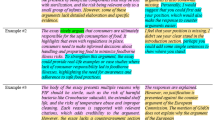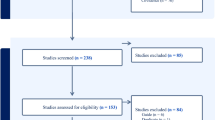Abstract
This manuscript focuses on how students make sense of proofs. Participants were students who engaged in peer-review conferences of each other’s attempted proofs in a graduate-level real analysis course for mathematics teachers. Building on the concept of distance from conversational analysis, we distinguish how three types of distance (epistemic, rhetorical, and ontological) between a student and a particular claim influence sensemaking. This article also explores the impact of students’ sensemaking on their perceptions of proof.
Similar content being viewed by others
Notes
Continuity: Let f: D → R, where D is a subset of R. We say that f is continuous on D, if for every x0 in D, f is continuous at x0. We say f is continuous at x0 if, for every ε > 0 there exists a δ > 0 such that for all x in D with |x−x0|< δ, |f(x)–f(x0)| < ε.
Uniform continuity: Let f: D → R, where D is a subset of R. We say that f is uniformly continuous on D, if for every ε > 0 there exists a δ > 0 such that for all s,t in D with |s−t|< δ, |f(s)–f(t)| < ε.
A single student discussed deep engagement in a prior inquiry-based proof course. This was the only instance of connection and exploration in the prior courses category.
References
Boaler, J., & Greeno, J. G. (2000). Identity, agency, and knowing in mathematics worlds. In J. Boaler (Ed.), Multiple Perspectives on Mathematics Teaching and Learning (pp. 171–200). Ablex Publishing.
Bressoud, D. M. (2007). A radical approach to real analysis. Mathematical Association of America.
Byrne, M. (2014). Changes in student proving skills and attitudes following a cooperative learning seminar (unpublished doctoral dissertation). The University of New Mexico.
Conlin, L. D., & Scherr, R. E. (2018). Making space to sensemake: Epistemic distancing in small group physics discussions. Cognition and Instruction, 36(4), 396–423. https://doi.org/10.1080/07370008.2018.1496918
Corbin, J., & Strauss, A. (2007). Basics of qualitative research: techniques and procedures for developing grounded theory. Sage.
Ernest, P. (1992). The popular image of mathematics. Humanistic Mathematics Network Journal, 1(8), 53–55.
Hersh, R. (1997). What is mathematics, really? Oxford University Press.
Mamona-Downs, J., & Downs, M. (2010). Necessary realignments from mental argumentation to proof presentation. In V. Durand-Guerrier, S. Soury-Lavergne, & F. Arzarello (Eds.), Proceedings of CERME 6. Institut National de Recherche Pedagogique: Lyon, France.
Mejia-Ramos, J. P., Fuller, E., Weber, K., Rhoads, K., & Samkoff, A. (2012). An assessment model for proof comprehension in undergraduate mathematics. Educational Studies in Mathematics, 79(1), 3–18. https://doi.org/10.1007/s10649-011-9349-7
Moore, R. C. (1994). Making the transition to formal proof. Educational Studies in Mathematics, 27(3), 249–266. https://doi.org/10.1007/BF01273731
Reinholz, D. L. (2016). The assessment cycle: A model for learning through peer assessment. Assessment & Evaluation in Higher Education, 41(2), 301–315. https://doi.org/10.1080/02602938.2015.1008982
Reinholz, D. L. (2018). Five practices for supporting inquiry in analysis. PRIMUS, 30(1), 19–35. https://doi.org/10.1080/10511970.2018.1500955
Rudin, W. (1964). Principles of mathematical analysis. McGraw-Hill.
Sadler, D. R. (1989). Formative assessment and the design of instructional systems. Instructional Science, 18(2), 119–144. https://doi.org/10.1007/BF00117714
Selden, A., & Selden, J. (2014). The genre of proof. In M. N. Fried & T. Dreyfus (Eds.), Mathematics & mathematics education: Searching for common ground (pp. 248–251). Springer.
Selden, A., & Selden, J. (2017). A comparison of proof comprehension, proof construction, proof validation and proof evaluation. In R. Göller, R. Biehler, R. Hochmuth, & H. Rück (Eds.), Proceedings of the Conference on Didactics of Mathematics in Higher Education as a Scientific Discipline (pp. 339–345) Khdm-report 17-05. https://kobra.uni-kassel.de/handle/123456789/2016041950121. Accessed 7 Jan 2020.
Weber, K. (2008). How mathematicians determine if an argument is a valid proof. Journal for Research in Mathematics Education, 39(4), 431–459.
Acknowledgements
The authors thank Martha Byrne and Cathery Yeh for their invaluable support in revising this manuscript. They also thank V. Rani Satyam, Niral Shah, and Keith Weber for their suggestions to deepen the literature review.
Author information
Authors and Affiliations
Contributions
DLR wrote the first draft, created coding scheme, and led analysis. MEP supported double coding, provided edits and feedback on manuscript.
Corresponding author
Ethics declarations
Conflicts of interest/competing interests
None.
Code availability
N/A
Additional information
Publisher’s note
Springer Nature remains neutral with regard to jurisdictional claims in published maps and institutional affiliations.
Rights and permissions
About this article
Cite this article
Reinholz, D.L., Pilgrim, M.E. Student sensemaking of proofs at various distances: the role of epistemic, rhetorical, and ontological distance in the peer review process. Educ Stud Math 106, 211–229 (2021). https://doi.org/10.1007/s10649-020-10010-3
Accepted:
Published:
Issue Date:
DOI: https://doi.org/10.1007/s10649-020-10010-3




